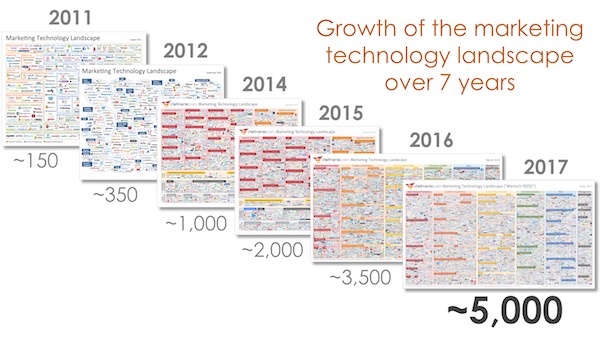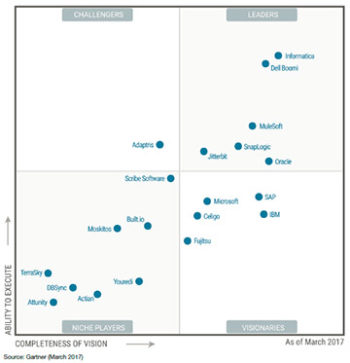Recently we had the pleasure of presenting “Simplifying Data Integration for the Cloud” on our BrightTALK webinar channel — if you happened to miss it, you can watch the replay above. (Click here if you don’t see the player.) Today we’re sharing a few selected insights from the presentation.
Cloud Adoption: Where We Are Today
Every year between 2009 and 2016, the cloud appeared on Gartner’s list of the top 10 strategic technology trends. The reason why it dropped off in 2016 is simple — it was no longer a trend. It had become an integral part of mainstream business and technology practices. The public cloud service market grew 18% in 2017 from 2016, public cloud computing spending is expected to grow almost $100B by 2020, and global cloud IT market revenue is expected to more than double to $390B in 2020.
As organizations became more comfortable with the cloud, the demand for cloud-based apps skyrocketed, and software providers responded. By 2020, spending on public cloud computing is expected to more than double, as is global cloud IT market revenue. In marketing technology alone, the number of cloud apps grew from about 150 in 2011 to more than 5,000 in 2017:

Source: Scott Brinker, “Marketing Technology Landscape Supergraphic (2017): Martech 5000”
More companies than ever are realizing the flexibility, scalability, and other benefits of cloud applications … but with this evolution, some challenges have arisen along the way.
The Data Silo Challenge
As use of cloud-based applications continues to spread, many organizations are experiencing situations in which each department owns its own cloud applications and its own data. When data needs to be shared between departments, the process is often manual, encompassing all the tedium, latency, and risk of error that tend to surround manual processes.
If organizations are to maximize the benefits of using cloud-based applications, they must expand their master data management (MDM) to encompass the cloud as well as on-premise assets, starting with data integration.
Data integration is one of the top challenges enterprises are facing in SaaS deployments and ranks among executives’ top concerns in adopting SaaS solutions. Successful data integration not only moves data “from A to B,” but also transforms and consolidates the data in a way that helps the organization achieve its business goals.
The iPaaS Solution
If data silos within organizations continue to grow, the situation will quickly become unmanageable. Fortunately, there is a solution.
Integration platforms as a service (iPaaS) are designed to enable development and management of data integration, connecting any combination of on-premise and cloud-based applications.
iPaaS solutions carry out a variety of integration patterns and provide secure access to data when and where it’s needed. Since they’re based in the cloud, they offer the flexibility and scalability of a typical cloud service. Perhaps most important of all, an iPaaS serves as a central point of interaction for various applications and services across an enterprise’s entire cloud architecture.
A robust iPaaS solution also offers the benefits of
- Automation: Allows all integration tasks run automatically, with no need for manual processing or human intervention
- Ease of use: Provides intuitive, web-based visual development console with drag-and-drop capabilities
- Enterprise standards: Built to offer high availability and scalability and covers a broad range of SaaS solutions
- Security: Designed to process data behind your firewall
Choosing Your iPaaS Solution
As the need for data integration solutions has grown, so has the market for iPaaS solutions. Gartner’s latest “Magic Quadrant for Enterprise Integration Platform as a Service, Worldwide” report ranked the most popular options, with Informatica emerging as the leader.

Once your iPaaS solution is in place, the next step is to choose a connector — an interface that connects to a system, application, file or file container (folder/directory) to perform read/write operations to the contained objects. You can learn more about connectors by watching the webinar replay above.
With reliance on the cloud growing every day, the problem of data silos is only going to escalate — unless enterprises get a handle on their data integration. Implementing the right iPaaS solution with the right connector enables you to automate data sharing between systems and get the full benefit from your cloud-based architecture.
JayJay Zheng is a Director at Logic20/20. JayJay is a seasoned architect in large enterprise application implementation, and manages as well as leads a large distributed team to achieve the best possible success. His areas of focus fall into JEE, content management, cloud integration, data management, IAM, Big Data and IIot.

